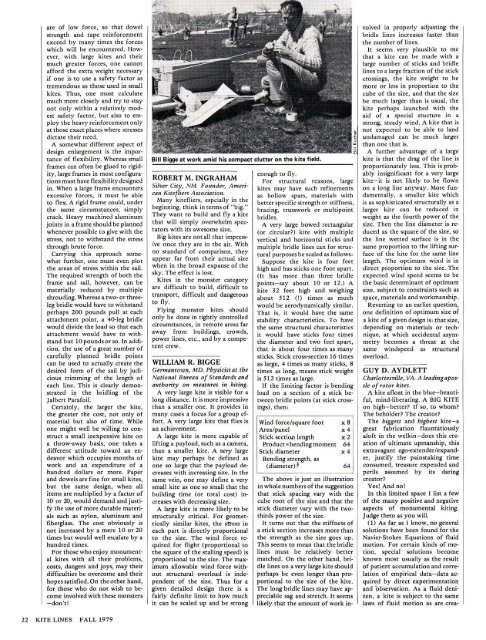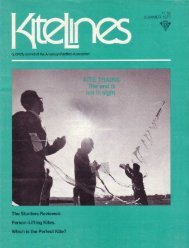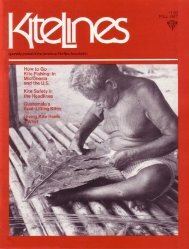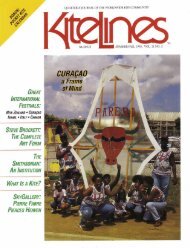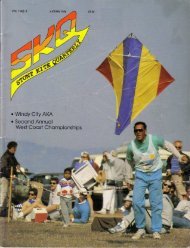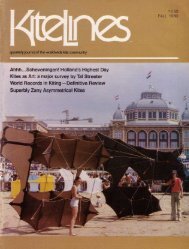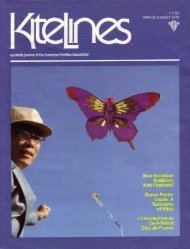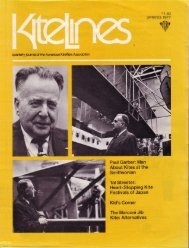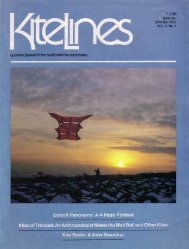Kite Lines - Vol.2 No. 4 - KiteLife
Kite Lines - Vol.2 No. 4 - KiteLife
Kite Lines - Vol.2 No. 4 - KiteLife
- No tags were found...
Create successful ePaper yourself
Turn your PDF publications into a flip-book with our unique Google optimized e-Paper software.
are of low force, so that dowelstrength and tape reinforcementexceed by many times the forceswhich will be encountered . However,with large kites and theirmuch greater forces, one cannotafford the extra weight necessaryif one is to use a safety factor astremendous as those used in smallkites . Thus, one must calculatemuch more closely and try to staynot only within a relatively modestsafety factor, but also to employthe heavy reinforcement onlyat those exact places where stressesdictate their need .A somewhat different aspect ofdesign enlargement is the importanceof flexibility . Whereas smallframes can often be glued to rigidity,large frames in most configurationsmust have flexibility designedin . When a large frame encountersexcessive forces, it must be ableto flex. A rigid frame could, underthe same circumstances, simplycrack . Heavy machined aluminumjoints in a frame should be plannedwhenever possible to give with thestress, not to withstand the stressthrough brute force .Carrying this approach somewhatfurther, one must even plotthe areas of stress within the sail .The required strength of both theframe and sail, however, can bematerially reduced by multipleshrouding . Whereas a two- or threelegbridle would have to withstandperhaps 200 pounds pull at eachattachment point, a 40-leg bridlewould divide the load so that eachattachment would have to withstandbut 10 pounds or so . In addition,the use of a great number ofcarefully planned bridle pointscan be used to actually create thedesired form of the sail by judicioustrimming of the length ofeach line . This is clearly demonstratedin the bridling of theJalbert Parafoil.Certainly, the larger the kite,the greater the cost, not only ofmaterial but also of time . Whileone might well be willing to constructa small inexpensive kite ona throw-away basis, one takes adifferent attitude toward an endeavorwhich occupies months ofwork and an expenditure of ahundred dollars or more . Paperand dowels are fine for small kites,but the same design, when allitems are multiplied by a factor of10 or 20, would demand and justifythe use of more durable materialssuch as nylon, aluminum andfiberglass. The cost obviously isnot increased by a mere 10 or 20times but would well escalate by ahundred times.For those who enjoy monumentalkites with all their problems,costs, dangers and joys, may theirdifficulties be overcome and theirhopes satisfied. On the other hand,for those who do not wish to becomeinvolved with these monsters-don't!Bill Bigge at work amid his compact clutter on the kite field .ROBERT M. INGRAHAMSilver City, NM . Founder, Amen.can <strong>Kite</strong>fliers Association .Many kitefliers, especially in thebeginning, think in terms of "big .'They want to build and fly a kitethat will simply overwhelm spectators with its awesome size .Big kites are not all that impressive once they are in the air . Withno standard of comparison, theyappear far from their actual sizewhen in the broad expanse of thesky . The effect is lost .<strong>Kite</strong>s in the monster categoryare difficult to build, difficult totransport, difficult and dangerousto fly .Flying monster kites shouldonly be done in tightly controlledcircumstances, in remote areas faraway from buildings, crowds,power lines, etc ., and by a competentcrew.WILLIAM R. BIGGEGermantown, MD. Physicist at theNational Bureau of Standards antauthority on measures in kiting .A very large kite is visible for along distance . It is more impressivethan a smaller one. It provides itmany cases a focus for a group offort . A very large kite that flies isan achievement .A large kite is more capable oflifting a payload, such as a camera,than a smaller kite . A very largekite may perhaps be defined asone so large that the payload de .creases with increasing size . In thesame vein, one may define a verysmall kite as one so small that thebuilding time (or total cost) increases with decreasing size .A large kite is more likely to bestructurally critical. For geometrically similar kites, the stress ineach part is directly proportionalto the size. The wind force requiredfor flight (proportional tothe square of the stalling speed) hproportional to the size . The maximumallowable wind force without structural overload is independentof the size . Thus for agiven detailed design there is afairly definite limit to how muchit can be scaled up and be strongenough to fly .For structural reasons, largekites may have such refinementsas hollow spars, materials withbetter specific strength or stiffness,bracing, trusswork or multipointbridles .A very large bowed rectangular(or circular?) kite with multiplevertical and horizontal sticks andmultiple bridle lines can for structuralpurposes be scaled as follows :Suppose the kite is four feethigh and has sticks one foot apart .(It has more than three bridlepoints-say about 10 or 12 .) Akite 32 feet high and weighingabout 512 (!) times as muchwould be aerodynamically similar .That is, it would have the samestability characteristics . To havethe same structural characteristicsit would have sticks four timesthe diameter and two feet apart,that is about four times as manysticks . Stick cross-section 16 timesas large, 4 times as many sticks, 8times as long, means stick weightis 512 times as large .If the limiting factor is bendingload on a section of a stick betweenbridle points (at stick crossings),then :The above is just an illustrationin whole numbers of the suggestionthat stick spacing vary with thecube root of the size and that thestick diameter vary with the twothirdspower of the size .It turns out that the stiffness ofa stick section increases more thanthe strength as the size goes up .This seems to mean that the bridlelines must be relatively bettermatched . On the other hand, bridlelines on a very large kite shouldperhaps be even longer than proportionalto the size of the kite .The long bridle lines may have appreciablesag and stretch . It seemslikely that the amount of work involvedin properly adjusting thebridle lines increases faster thanthe number of lines .It seems very plausible to methat a kite can be made with alarge number of sticks and bridlelines to a large fraction of the stickcrossings, the kite weight to bemore or less in proportion to thecube of the size, and that the sizebe much larger than is usual, thekite perhaps launched with theaid of a special structure in astrong, steady wind . A kite that isnot expected to be able to landundamaged can be much largerthan one that is .A further advantage of a largekite is that the drag of the line isproportionately less . This is probablyinsignificant for a very largekite-it is not likely to be flownon a long line anyway . More fundamentally,a smaller kite whichis as sophisticated structurally as alarger kite can be reduced inweight as the fourth power of thesize . Then the line diameter is reducedas the square of the size, sothe line wetted surface is in thesame proportion to the lifting surfaceof the kite for the same linelength . The optimum wind is indirect proportion to the size . Theexpected wind speed seems to bethe basic determinant of optimumsize, subject to constraints such asspace, materials and workmanship .Reverting to an earlier question,one definition of optimum size ofa kite of a given design is : that size,depending on materials or technique,at which accidental asymmetrybecomes a threat at thesame windspeed as structuraloverload .GUY D . AYDLETTCharlottesville, VA. A leading apos- tle of rotor kites.A kite afloat in the blue-beautiful,mind-liberating . A BIG KITEon high-better? If so, to whom?The beholder? The creator?The biggest and highest kite-agreat fabrication flauntatiouslyaloft in the welkin-does this creationof ultimate upmanship, thisextravagant ego-extender/expander,justify the painstaking timeconsumed, treasure expended andperils assumed by its daringcreator?Yes! And no!In this limited space I list a fewof the many positive and negativeaspects of monumental kiting .Judge them as you will .(1) As far as I know, no generalsolutions have been found for theNavier-Stokes Equations of fluidmotion . For certain kinds of motion,special solutions becomeknown most usually as the resultof patient accumulation and correlationof empirical data-data acquiredby direct experimentationand observation . As a fluid denizen,a kite is subject to the samelaws of fluid motion as are crea-


